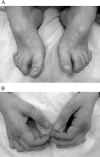Anesthetic Management of a Patient With Charcot-Marie-Tooth Disease
- PMID: 27269665
- PMCID: PMC4896046
- DOI: 10.2344/15-00010R1.1
Anesthetic Management of a Patient With Charcot-Marie-Tooth Disease
Abstract
Charcot-Marie-Tooth disease (CMTD) is a hereditary peripheral neuropathy and is characterized by progressive muscle atrophy and motor-sensory disorders in all 4 limbs. Most reports have indicated that major challenges with general anesthetic administration in CMTD patients are the appropriate use of nondepolarizing muscle relaxants and preparation for malignant hyperthermia in neuromuscular disease. Moderate sedation may be associated with the same complications as those of general anesthesia, as well as dysfunction of the autonomic nervous system, reduced perioperative respiratory function, difficulty in positioning, and sensitivity to intravenous anesthetic agents. We decided to use intravenous sedation in a CMTD patient and administered midazolam initially and propofol continuously, with total doses of 1.5 mg and 300 mg, respectively. Anesthesia was completed in 3 hours and 30 minutes without adverse events. We suggest that dental anesthetic treatment with propofol and midazolam may be effective for patients with CMTD.
Keywords: Charcot-Marie-Tooth disease; Intravenous sedation; Propofol.
Figures
References
-
- Harding AE, Thomas PK. The clinical features of hereditary motor and sensory neuropathy types I and II. Brain. 1980; 103: 259– 280. - PubMed
-
- Roelofse JA, Shipton EA. Anaesthesia for abdominal hysterectomy in Charcot-Marie-Tooth disease. A case report. S Afr Med J. 1985; 67: 605– 606. - PubMed
-
- Schmitt HJ, Münster T. Mivacurium-induced neuromuscular block in adult patients suffering from Charcot-Marie-Tooth disease. Can J Anaesth. 2006; 53: 984– 988. - PubMed
Publication types
MeSH terms
Substances
LinkOut - more resources
Full Text Sources
Other Literature Sources
Medical


